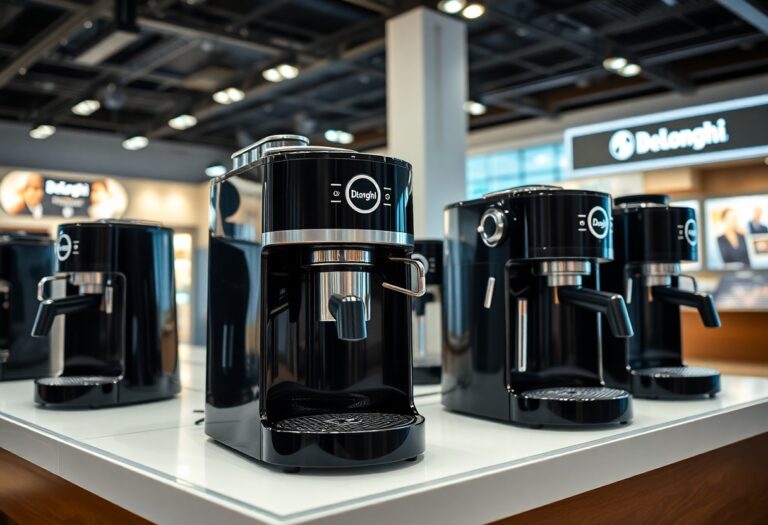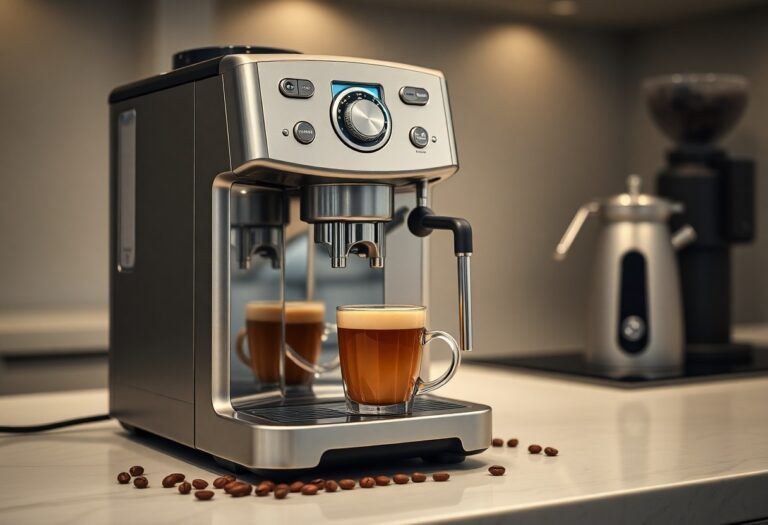What Happened to the Clover Coffee Machine – Technology History
Clover was once at the forefront of coffee brewing technology, capturing the attention of coffee enthusiasts worldwide. You may be curious about its journey, from its groundbreaking innovation to the challenges it faced in the competitive market. This machine revolutionized the way you brewed coffee, offering precise control over temperature and brewing time that resulted in exceptional flavor profiles. However, its unique appeal was not enough to secure its longevity, leading to a series of changes that ended in unexpected twists for the beloved machine. Join us as we explore the remarkable history of the Clover Coffee Machine.
Key Takeaways:
- The Clover Coffee Machine, known for its precision brewing technology, was developed in the mid-2000s and revolutionized the coffee brewing industry.
- In 2012, Starbucks acquired Clover, integrating its technology into select stores to enhance their coffee offerings.
- Despite its initial popularity and innovation, Clover machines eventually faced challenges in scalability and maintenance costs.
- Starbucks moved towards in-store barista preparation and pursuit of more efficient brewing methods, leading to the phased-out use of Clover machines.
- The legacy of Clover technology continues to influence premium coffee brewing, inspiring many home and commercial brewers in the coffee industry.
The Birth of the Clover Coffee Machine
Conceptualization and Development
You might be surprised to learn that the Clover Coffee Machine was born from a desire to create a more personal coffee brewing experience. Founded by Joseph M. and Paul Stack in 2005, Clover aimed to deliver the perfect cup through precision brewing. Their unique dual-brewing system allowed users to control not just the temperature but also variables like brew time and coffee-to-water ratio, offering exceptional flavor profiles that traditional machines couldn’t match.
Early Reception and Market Impact
When it hit the market, the Clover Coffee Machine garnered a wave of enthusiasm from coffee aficionados and baristas alike. Its innovative features and sleek design positioned it as a game-changer in specialty coffee, leading to rapid adoption in high-end cafes across the U.S. and beyond.
The Clover received widespread critical acclaim as soon as it debuted, setting a new standard with industry giants like Stumptown Coffee Roasters and Blue Bottle Coffee using it as their brewing backbone. The machine’s ability to extract the full potential of various coffee beans helped define the third wave coffee movement, emphasizing quality and craftsmanship. Early users reported notable improvements in flavor clarity, making the Clover an imperative tool for baristas aiming to enhance their coffee offerings, while its sales surged, indicating that the market was ready for premium, precision-driven brewing technology.

Revolutionary Brewing Technology
The Clover Coffee Machine introduced a paradigm shift in coffee preparation, merging traditional brewing methods with cutting-edge technology. By utilizing a revolutionary method of brewing known as vacuum brewing, the Clover provided unparalleled control over water temperature and brew time. This level of precision enabled baristas to extract distinct flavor profiles from various coffee beans, transforming each cup into a unique sensory experience.
How Clover Redefined Coffee Quality
The introduction of the Clover machine has fundamentally redefined global coffee standards by showcasing the importance of quality control. With its ability to highlight subtle notes and complex flavors in single-origin coffees, it empowered consumers and café owners to explore and appreciate artisanal coffee in ways that were previously impossible.
Technological Innovations Behind the Brew
Key innovations behind the Clover machine include a patented brewing process that employs precise temperature controls and a built-in grinder to ensure fresh grounds are used for each brew. The machine boasts a vacuum chamber system, which optimizes the extraction process and reduces bitterness, allowing for a cleaner and more vibrant flavor profile in your cup.
By integrating technology with the art of brewing, the Clover Coffee Machine utilizes advanced sensors to maintain optimal brewing conditions throughout the process. Temperature variations are minimized, ensuring that each batch of coffee retains its unique characteristics. With the ability to program different brewing recipes, you can explore an array of flavors tailored to your preferences. Additionally, the Clover incorporates a user-friendly interface, making it accessible to both skilled baristas and everyday coffee enthusiasts alike.
The Rise and Fall of Clover’s Popularity
Initial Success and Expansion
Clover gained significant traction quickly after its debut, captivating coffee enthusiasts with its innovative brewing technology. The machine’s ability to brew single cups of coffee with rich flavor and consistency elevated the coffee experience in cafes across the country. Within just a few years, Clover machines were featured in prominent coffee shops such as Starbucks and Peet’s, marking a period of rapid expansion into the specialty coffee market.
Factors Leading to Decline
Despite its initial success, several factors contributed to the decline of Clover’s popularity in the marketplace. The emergence of competing brewing technologies, coupled with high production costs and limited scalability, hindered its growth. Additionally, the perception of Clover machines as a niche product rather than a standard offering made adoption by more conservative coffee retailers challenging. Assume that this combination of challenges created a perfect storm for Clover’s eventual downturn.
- Emergence of competitors that offered more affordable solutions
- High production costs that hindered profitability
- Limited scalability which restricted market penetration
- Niche product perception that deterred broad adoption
Delving deeper into the decline, you can see that the coffee landscape shifted rapidly, with new technologies such as manual espresso machines and pour-over techniques gaining popularity. As coffee enthusiasts sought a more hands-on, artisanal approach, Clover’s automated system began to feel less appealing. Additionally, the acquisition by Starbucks aimed at placing Clover in more stores backfired due to an inability to meet demand, which diluted its exclusivity. Assume that these evolving market dynamics played a critical role in Clover’s fall from grace.
- Artisanal brewing trends influencing consumer preferences
- Starbucks acquisition complicating business strategy
- Inability to scale production efficiently
- Market saturation contributing to declining interest

Acquisition and Legacy
The Clover coffee machine’s legacy is solidified through its acquisition by Starbucks in 2008, which marked a pivotal shift in the landscape of specialty coffee. This move demonstrated Starbucks’ commitment to elevating the coffee experience, as they sought to integrate Clover’s innovative technology into their stores. Following the purchase, the machines were introduced in select locations, enhancing customers’ perception of premium coffee and further solidifying the brand’s reputation as a leader in coffee quality.
Starbucks’ Purchase and Its Implications
Starbucks acquiring Clover for $100 million was a game-changer in the coffee industry. This strategic buyout allowed Starbucks to leverage Clover’s advanced brewing capabilities, consequently boosting its coffee quality and aligning with the growing demand for specialty beverages. This investment not only helped Starbucks differentiate itself from competitors but also paved the way for a more bespoke coffee experience across its global network of stores.
Clover’s Influence on Modern Coffee Culture
Clover’s impact on coffee culture is notable, as it introduced the concept of precision brewing to a broader audience. With its ability to fine-tune variables such as temperature and brew time, the Clover machine helped coffee enthusiasts appreciate the nuances of flavor. As a result, you can see a rise in artisanal coffee shops embracing similar technologies and techniques, ensuring that the standards of quality and craft in coffee-making continue to evolve.
This shift has not only influenced consumer preferences but has also altered how baristas approach their craft. Many cafes now emphasize single-origin beans, experimenting with various brewing methods inspired by Clover’s precision approach. You’re more likely to encounter detailed flavor profiles and brewing recommendations, as coffee becomes an artisanal product rather than just a daily caffeine fix. This evolution in perception has helped establish coffee culture as a sophisticated culinary art form, encouraging exploration and education within the coffee community.
Lessons Learned from the Clover Experience
Your exploration of Clover’s journey reveals key lessons about innovation and market dynamics. One standout takeaway emphasizes the importance of adapting to consumer preferences—creating products that not only meet needs but also resonate emotionally with customers. While Clover machines showcased advanced technology, their eventual decline underscores that innovation must align with consumer values and experiences for lasting success.
The Role of Innovation in Consumer Preferences
Innovation isn’t merely about offering the latest technology; it also hinges on understanding consumer desires. Clover’s machine introduced unique coffee brewing capabilities, capturing attention with its precision and quality. However, as the market evolved, your audience’s preferences shifted toward convenience and simplicity. As a result, Clover’s high-tech approach became a double-edged sword, illustrating that even groundbreaking inventions require alignment with user preferences.
Sustainability and Market Viability
Consumers increasingly prioritize sustainability in their purchasing decisions, influencing market viability for products like Clover. Your awareness of environmental concerns is vital in shaping how businesses approach their offerings. Clover’s challenges reflect a broader shift where eco-friendly practices, from sourcing materials to energy-efficient operations, play a pivotal role in attracting a dedicated customer base.
The sustainability conversation has shifted from a niche consideration to a mainstream expectation, influencing purchasing decisions across demographics. For instance, a 2022 survey indicated that 72% of consumers are more likely to purchase from brands committed to sustainability. Clover’s integration of environmentally friendly practices could have improved its market viability by attracting environmentally aware coffee enthusiasts. By aligning product offerings with sustainable values, brands increase not only their appeal but also help foster a loyalty that goes beyond mere transactions, ultimately contributing to a healthier planet and a more engaged customer base.
Final Words
The history of the Clover Coffee Machine demonstrates the dynamic relationship between technology and consumer preferences in the coffee industry. As you examine into this tale, you see how advancements in brewing methods can influence business decisions and customer experiences. If you’re curious about the recent changes related to the Clover machines, you might want to check out the insights on Why is Starbucks getting rid of the Clover machines? to gain a deeper understanding of this transition.
FAQ
Q: What is the Clover Coffee Machine and why is it significant in the coffee industry?
A: The Clover Coffee Machine is an innovative brewing device that was introduced in the early 2000s, designed to enhance the coffee brewing process by showcasing the unique flavors of different coffee beans. Its significance lies in its ability to brew single cups of coffee with precision, allowing for optimal extraction and temperature control. This machine brought specialty coffee craftsmanship to a new level, impacting how coffee was served in cafes and prompting a shift towards high-quality, artisanal coffee experiences.
Q: Who developed the Clover Coffee Machine and when was it launched?
A: The Clover Coffee Machine was developed by a San Francisco-based company founded by entrepreneur George Howell and his team. It was first launched in 2005, quickly gaining attention for its cutting-edge technology and ability to brew coffee in a way that highlighted the nuances of different beans. Its introduction marked a turning point in coffee technology, appealing to both baristas and coffee enthusiasts alike.
Q: What happened to the Clover Coffee Machine after its initial success?
A: After its successful launch, the Clover Coffee Machine gained popularity and was adopted by numerous specialty coffee shops. However, in 2009, it was acquired by Starbucks, which integrated the technology into its own stores. While the Clover was celebrated in the beginning, its availability became limited as Starbucks focused on scaling its coffee offerings, resulting in fewer Clover machines being accessible in independent cafes. Over time, the unique value proposition of the machine began to fade as the market evolved.
Q: Are Clover Coffee Machines still in use today, and if so, where can they be found?
A: Yes, Clover Coffee Machines are still in use today, albeit in more niche settings. While many have been removed from large retail chains, a number of independent specialty coffee shops and high-end cafes continue to utilize it as part of their brewing arsenal. The machine remains a symbol of artisanal coffee preparation, and its fans appreciate its capability to brew high-quality, single-origin coffees.
Q: What advancements in coffee technology have emerged since the Clover Coffee Machine?
A: Since the introduction of the Clover Coffee Machine, various advancements in coffee brewing technology have emerged. These include improvements in espresso machines, pour-over systems, and immersion brewers that use precision temperature control and timing functions. Many coffee enthusiasts now favor alternatives like the Chemex or pour-over devices that allow greater control over extraction. Additionally, smartphone connectivity and smart appliances have begun to influence brewing methods, aligning with modern consumer needs for convenience and customization.







